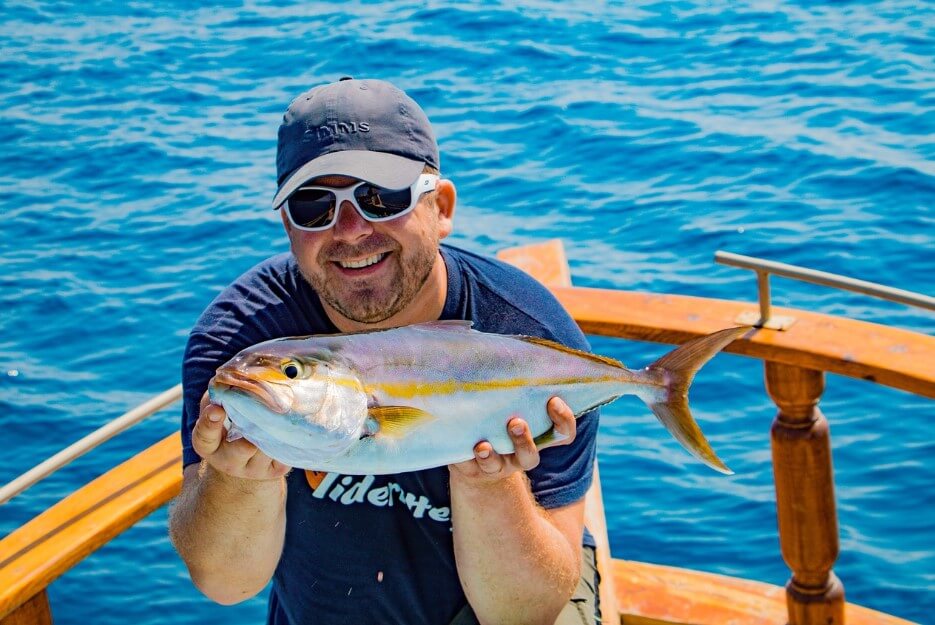Bluefin Tuna Recipes Bringing the Oceans Richness to Your Plate

Experience a culinary adventure with our delicious bluefin tuna recipes! Known for its rich flavor and tender texture, bluefin tuna is a prized fish that brings the ocean’s finest offerings straight to your plate. Whether you prefer a seared tuna steak, a refreshing Asian-inspired dish, or a mouthwatering tuna tartare, our collection of recipes will satisfy your cravings and elevate your dining experience.
Indulge in the luxuriously decadent taste of bluefin tuna as you savor each bite, experiencing the natural richness and depth of flavors that only the ocean can provide.
Our carefully curated recipes highlight the versatility of bluefin tuna, showcasing its ability to shine in a variety of culinary styles and cuisines. From elegant sushi rolls to hearty pasta dishes, each recipe is crafted to enhance the natural flavors of the tuna, allowing you to enjoy the unparalleled taste of this exquisite fish.
Whether you’re a seafood enthusiast or simply looking to expand your culinary repertoire, our bluefin tuna recipes will satisfy your cravings and delight your taste buds with their exceptional flavors and textures.
Experience the true taste of the ocean’s richness on your plate with our tantalizing bluefin tuna recipes. Elevate your dining experience and impress your guests with these gourmet creations that bring the flavors of the sea straight to your table. Don’t miss out on this opportunity to indulge in the extraordinary flavors of bluefin tuna.
Explore the Ocean’s Bounty
Immerse yourself in the wonders of the deep blue sea and discover the exquisite richness it has to offer. With our selection of Bluefin Tuna recipes, you can bring the boundless flavors of the ocean to your plate. Indulge in the delicate textures and savory tastes that this prized fish brings.
Delicious Bluefin Tuna Recipes
Our Bluefin Tuna recipes are carefully crafted to showcase the exceptional qualities of this magnificent creature. From sashimi to seared steaks, each dish is designed to tantalize your taste buds and transport you to the tranquil depths of the ocean.
Bringing the Ocean’s Bounty to Your Table
With every bite, you can savor the distinct flavors that have made Bluefin Tuna a legendary delicacy. The tender flesh, infused with the essence of the sea, will leave you craving for more. Whether grilled, poached, or roasted, our recipes are sure to elevate your dining experience and create lasting memories.
So, dive right in and explore the ocean’s bounty. Let the allure of Bluefin Tuna captivate your senses, as you embark on a culinary journey like no other.
Discover the Bluefin Tuna
The Bluefin Tuna is a majestic and highly prized fish that inhabits the depths of the ocean. Known for its exceptional taste and rich flavor, the Bluefin Tuna is a favorite among seafood lovers.
A Culinary Delight
With its vibrant colors and succulent meat, the Bluefin Tuna is a culinary delight that brings a taste of the ocean’s richness to your plate. Whether you prefer it grilled, seared, or served raw as sashimi, there are countless recipes that showcase the versatility of this extraordinary fish.
Sustainable Fishing
At Bluefin Tuna Recipes, we are committed to promoting sustainable fishing practices to ensure the preservation of this magnificent species. We source our Bluefin Tuna responsibly, supporting fisheries that adhere to strict regulations and work towards maintaining healthy populations.
Join us on a journey to discover the wonders of the Bluefin Tuna and indulge in a culinary experience like no other. We invite you to explore our collection of tantalizing recipes that will bring the ocean’s freshness and flavors to your table.
Unlock the Deliciousness
Are you ready to embark on a culinary journey that combines the finest flavors of the ocean with the expert touch of our Bluefin Tuna Recipes? Prepare to experience a taste sensation that will bring the richness of the sea directly to your plate.
Our team of skilled chefs has carefully curated a collection of tantalizing recipes that showcase the versatility and exquisite flavor of Bluefin Tuna. From grilled steaks to sushi rolls, our recipes allow you to explore the endless possibilities and create dishes that will impress even the most discerning palates.
Bringing together the freshest ingredients and innovative cooking techniques, our Bluefin Tuna Recipes offer a truly unique and delightful dining experience. Indulge in the succulent tenderness of grilled Bluefin Tuna paired with zesty citrus flavors or savor the melt-in-your-mouth texture of Bluefin Tuna sashimi.
Step into your kitchen and unlock the deliciousness that awaits. With our easy-to-follow recipes, you can transform your Bluefin Tuna into culinary masterpieces that will leave your taste buds wanting more. Whether you’re a seasoned chef or a cooking enthusiast, our recipes ensure that you’ll achieve restaurant-quality results every time.
Prepare to elevate your dining experience and discover a world of flavor with Bluefin Tuna. Don’t settle for ordinary meals when you can bring the extraordinary to your plate. Unlock the deliciousness today and let the richness of the ocean take center stage in your kitchen.
Healthy and Nutrient-Rich
When it comes to healthy and nutrient-rich options, Bluefin Tuna is hard to beat. Packed with vitamins, minerals, and omega-3 fatty acids, this delicious fish not only brings the ocean’s richness to your plate, but it also offers a range of health benefits.
Rich in Omega-3 Fatty Acids
Bluefin Tuna is known for its high omega-3 fatty acid content. These essential fats are crucial for maintaining a healthy heart, reducing inflammation, and improving brain function. By incorporating Bluefin Tuna into your diet, you can boost the levels of these beneficial fats in your body.

A Source of High-Quality Protein
Tuna is an excellent source of lean protein, making it an ideal choice for those looking to build and repair muscles. Protein is essential for supporting muscle growth, aiding in weight loss, and promoting overall health. By enjoying Bluefin Tuna recipes, you can easily meet your daily protein needs.
So, if you’re looking for a healthy and delicious addition to your meals, Bluefin Tuna is the perfect choice. With its richness in nutrients and omega-3 fatty acids, it not only brings the flavors of the ocean to your plate, but it also offers numerous health benefits. Try out our Bluefin Tuna recipes today and discover a new level of taste and nutrition!
Easy Bluefin Tuna Recipes
Looking to add a touch of sophistication to your plate? Our easy Bluefin Tuna recipes are the answer. With its unrivaled richness and melt-in-your-mouth texture, Bluefin Tuna is the ultimate indulgence for seafood lovers.
Bringing the ocean’s freshness straight to your kitchen, these recipes offer a variety of exciting flavors and culinary experiences. From mouthwatering sashimi to delectable seared steaks, our Bluefin Tuna recipes will take your taste buds on an unforgettable journey.
Not only is Bluefin Tuna delicious, but it’s also incredibly versatile. Whether you prefer a tangy citrus glaze, a savory soy marinade, or a spicy chili rub, our recipes will show you how to perfectly complement the natural flavors of this prized fish.
Don’t miss out on the chance to impress your family and friends with restaurant-worthy dishes made right at home. With our easy Bluefin Tuna recipes, you’ll elevate your cooking skills and create culinary masterpieces in no time.
So why wait? Dive into the world of Bluefin Tuna and experience the true richness of the ocean on your plate today!
From Sea to Table
At Bluefin Tuna Recipes, we are dedicated to bringing the ocean’s richness to your plate. Our mission is to share the incredible flavors and nutritious properties of bluefin tuna with food lovers like you.
Bluefin tuna is one of the most sought-after and prized fish in the world. With its delicate texture and rich flavor, it is the perfect ingredient to elevate your meals to another level.
Our team of expert chefs have curated a collection of mouth-watering recipes that showcase the versatility of bluefin tuna. Whether you’re in the mood for a refreshing ceviche, a hearty grilled steak, or a savory sushi roll, we have the perfect recipe for you.
Explore Our Recipes
Discover a world of culinary possibilities with our wide range of bluefin tuna recipes. From traditional Japanese dishes to modern interpretations, our recipes will take you on a gastronomic journey like no other.
Try our Bluefin Tuna Tataki, a seared tuna dish marinated in a delicate soy-based sauce. Or indulge in our Bluefin Tuna Carpaccio, thinly sliced tuna drizzled with a zesty citrus dressing. For something more adventurous, our Bluefin Tuna Tartare with Avocado and Wasabi is a must-try.
The Finest Quality
At Bluefin Tuna Recipes, we source only the highest-quality bluefin tuna to ensure that you experience the true taste of the ocean. Our commitment to sustainability means that we work closely with trusted fishermen who employ responsible fishing practices.
Each piece of bluefin tuna is carefully selected and expertly handled to preserve its freshness and flavors. We believe that by using the best ingredients, we can deliver a culinary experience that is unparalleled.
| Bluefin Tuna Recipes | ||
|---|---|---|
| Bluefin Tuna Tataki | Bluefin Tuna Carpaccio | Bluefin Tuna Tartare with Avocado and Wasabi |
| Ingredients | Ingredients | Ingredients |
| Instructions | Instructions | Instructions |
Creative and Versatile Dishes
Our Bluefin Tuna Recipes offer a variety of creative and versatile dishes that will bring the richness of the ocean to your plate. Whether you’re a seasoned chef or a culinary enthusiast, our recipes will take you on a flavorful journey.
From classic dishes like Bluefin Tuna Sashimi and Bluefin Tuna Tartare to more adventurous creations like Bluefin Tuna Tacos and Bluefin Tuna Salad with Citrus Dressing, our recipes showcase the versatility of this prized fish.
Experience the delicate texture and bold flavor of Bluefin Tuna in dishes such as Bluefin Tuna Poke Bowl, Bluefin Tuna Ceviche, and Bluefin Tuna Carpaccio. These dishes combine the freshness of the sea with the vibrant colors and flavors of a well-balanced meal.
Impress your guests with Bluefin Tuna Burgers, Bluefin Tuna Steaks with Soy Glaze, or Bluefin Tuna Teriyaki Skewers. These dishes bring together the richness of Bluefin Tuna with a variety of complementary ingredients, resulting in a delightful fusion of flavors.
Whether you prefer your Bluefin Tuna raw, grilled, or seared, our recipes will help you create dishes that will satisfy your cravings and impress your taste buds. So, start bringing the ocean’s richness to your plate today with our mouthwatering Bluefin Tuna Recipes!
International Bluefin Tuna Cuisine
Discover the ocean’s finest delicacies with our exquisite collection of bluefin tuna recipes.
Take a culinary journey to the depths of the sea and experience the richness of flavors that the bluefin tuna brings to your plate. From Japan to Spain, we present you with a range of international dishes that showcase the versatility and taste of this magnificent species.
Indulge in the renowned Japanese specialty, Bluefin Tuna Sashimi, where thinly sliced pieces of the freshest tuna melt in your mouth, offering a pure and delicate flavor that will leave you craving for more.
Experience the lively and vibrant atmosphere of a Spanish tapas bar with our Bluefin Tuna Tartare featuring diced tuna mixed with zesty flavors like lime, cilantro, and avocado, creating a perfect balance of textures and tastes.
Embrace the Mediterranean charm with the classic Grilled Bluefin Tuna Steak infused with fragrant herbs and drizzled with a tangy lemon dressing, transporting you to the azure coastlines of Italy.
For a fusion of flavors, dive into the Bluefin Tuna Poke Bowl inspired by Hawaiian cuisine, combining seasoned tuna, fresh veggies, and a tantalizing sauce, offering a refreshing and wholesome meal that will satisfy your taste buds.
Embark on a culinary adventure and let our international bluefin tuna cuisine take you on a journey of unique flavors and culinary experiences that will leave an indelible impression on your palate.
Bluefin Tuna: A Sustainable Choice
When it comes to choosing seafood for your plate, why not consider bluefin tuna? Not only does it offer delicious flavors and a delicate texture, but it is also a sustainable choice that brings the richness of the ocean to your dining experience.
Bluefin tuna, known for its deep blue coloring and torpedo-like shape, is a highly sought-after fish in the culinary world. With its high fat content, it is perfect for a variety of recipes that highlight its natural flavors.
However, the increasing demand for bluefin tuna has led to overfishing and a decline in their population. This is why it is crucial to choose sustainable sources when purchasing bluefin tuna.
By making a conscious effort to support sustainable fishing practices, you can enjoy the ocean’s bounty while also helping to protect and preserve this incredible species. Look for labels such as Marine Stewardship Council (MSC) certification, which ensures that the tuna you consume comes from responsibly managed fisheries.
When shopping for bluefin tuna, consider purchasing from local and reputable suppliers who prioritize sustainability. Supporting these businesses not only helps the environment but also supports the communities that rely on sustainable fishing practices.
In addition to being a sustainable choice, bluefin tuna offers numerous health benefits. Rich in omega-3 fatty acids, it is a great source of heart-healthy fats. It is also packed with vitamins and minerals, making it a nutritious addition to any diet.
So, the next time you’re planning a meal, consider bluefin tuna. With its exquisite taste and sustainable qualities, it is a choice that both satisfies your cravings and supports the well-being of our oceans.
Master the Art of Cooking Bluefin
When it comes to bringing the ocean’s richness to your plate, bluefin tuna is a true delicacy. With its firm yet tender texture and rich, buttery flavor, bluefin tuna is a versatile ingredient that can be prepared in a variety of ways. Whether you prefer it seared, grilled, or raw in sushi, there are countless recipes that showcase the incredible taste and texture of this prized fish.
Seared Bluefin Tuna
One of the most popular ways to prepare bluefin tuna is by searing it. To master this technique, start by heating a skillet over high heat until it’s smoking hot. Rub the tuna steaks with a mixture of salt, black pepper, and olive oil, then carefully place them in the hot skillet. Sear each side for about 1-2 minutes, or until the surface is nicely browned and the center is still rare. Serve the seared bluefin tuna with a drizzle of soy sauce and a squeeze of lemon for a simple, yet incredibly flavorful dish.
Grilled Bluefin Tuna Steaks
If you prefer the smoky flavors that come from grilling, then grilled bluefin tuna steaks are a must-try. Begin by preheating your grill to high heat. Season the tuna steaks with a marinade of your choice, such as soy sauce, garlic, and ginger, then place them directly on the grill grates. Cook for about 4-5 minutes per side, or until the tuna is opaque and flakes easily with a fork. The grilled bluefin tuna steaks can be served as a main course or sliced and added to salads for a refreshing summer meal.
Raw Bluefin Tuna Sushi
If you’re feeling adventurous, why not try your hand at making your own bluefin tuna sushi? Begin by selecting the freshest bluefin tuna you can find, preferably sashimi-grade. Cut the tuna into thin slices and serve it atop seasoned sushi rice. Garnish with wasabi, pickled ginger, and soy sauce, and enjoy the pure, unadulterated taste of bluefin tuna in its raw form.
Bluefin tuna is truly a treasure from the ocean, and mastering the art of cooking it will elevate your culinary skills to new heights. Whether you’re searing it to perfection, grilling it for a smoky flavor, or enjoying it raw in sushi, the possibilities are endless. Get creative with your bluefin tuna recipes and discover the exquisite flavors that this remarkable fish has to offer.
Indulge in Bluefin Tuna Today
Are you looking for new and delicious recipes to try? Look no further! Our Bluefin Tuna recipes are sure to bring the ocean’s richness to your plate. These recipes have been carefully crafted to highlight the unique flavors and textures of this special fish.
Whether you prefer your Bluefin Tuna grilled, seared, or raw, we have a recipe for you. Our expert chefs have created a variety of dishes that will satisfy any palate. From Bluefin Tuna sushi rolls to grilled Bluefin Tuna steaks, we have it all.
Not only is Bluefin Tuna delicious, but it is also a healthy choice. Packed with omega-3 fatty acids and high-quality protein, Bluefin Tuna is a smart addition to any diet. Indulge in this nutritious and flavorful fish today!
| Recipe | Description |
|---|---|
| Sushi Rolls | Experience the delicate flavors of Bluefin Tuna in these expertly rolled sushi rolls. |
| Grilled Steaks | Enjoy the smoky flavors of grilled Bluefin Tuna steaks, cooked to perfection. |
| Tuna Tartare | Savor the fresh taste of raw Bluefin Tuna, combined with tangy flavors and crunchy textures. |
| Tuna Poke Bowl | Indulge in a colorful and nutritious bowl filled with Bluefin Tuna, fresh vegetables, and flavorful toppings. |
Don’t miss out on the opportunity to indulge in the exquisite taste of Bluefin Tuna. Try our recipes today and discover a whole new world of flavors!
Q&A:
What are some popular recipes for cooking bluefin tuna?
Some popular recipes for cooking bluefin tuna include seared tuna with soy glaze, grilled bluefin tuna steaks, and bluefin tuna tartare.
Can I bake bluefin tuna?
Yes, you can bake bluefin tuna. One delicious recipe is to marinate the tuna in a mixture of soy sauce, ginger, and garlic, then bake it in the oven for about 10-15 minutes.
Is bluefin tuna healthy to eat?
Yes, bluefin tuna is a healthy option. It is a good source of protein and contains omega-3 fatty acids, which are beneficial for heart health.
Where can I buy fresh bluefin tuna?
You can buy fresh bluefin tuna at seafood markets, specialty grocery stores, or online fish markets. It is important to ensure that the tuna is sourced sustainably and is of high quality.





